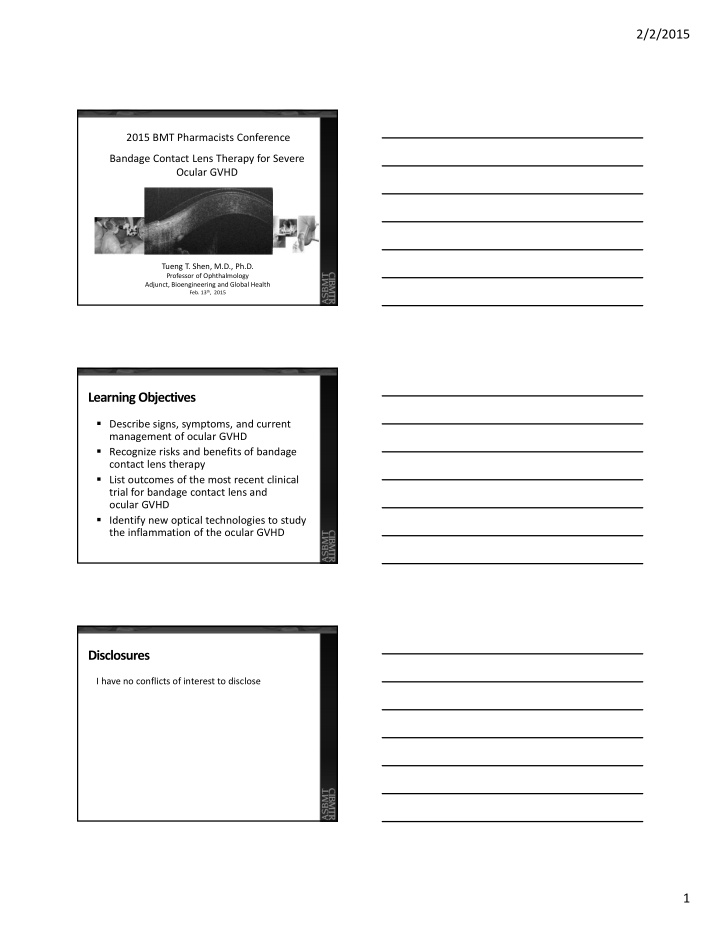



2/2/2015 2015 BMT Pharmacists Conference Bandage Contact Lens Therapy for Severe Ocular GVHD Tueng T. Shen, M.D., Ph.D. Professor of Ophthalmology Adjunct, Bioengineering and Global Health Feb. 13 th , 2015 Learning Objectives Describe signs, symptoms, and current management of ocular GVHD Recognize risks and benefits of bandage contact lens therapy List outcomes of the most recent clinical trial for bandage contact lens and ocular GVHD Identify new optical technologies to study the inflammation of the ocular GVHD Disclosures I have no conflicts of interest to disclose 1
2/2/2015 Graft ‐ versus ‐ Host Disease (GVHD) GVHD is a major complication of allogenic tissue/hematopoietic stem cell transplantation 60% of GVHD patients have ocular involvement with significant compromise in quality of life due to ocular symptoms (such as severe photophobia, eye pain and decreased visual acuity) Dry eye disease (DED) and GVHD DED is the most commonly found eye condition in GVHD DED is a diagnostic sign of chronic GVHD Limited success for DED treatment in GVHD patients Ocular surface in GVHD Poor tear film Irregular corneal epithelium Conjunctiva inflammation Significantly impact the quality of life No reliable measure to accurately quantify symptoms 2
2/2/2015 GVHD of the ocular surface An abundant inflammatory cell Obstructed orifices of meibomian infiltration at periductal areas gland and Zeiss gland on eye lid margin of lacrimal gland chronic GVHD with severely fibrotic tarsal conjunctiva Ogawa et al. SCIENTIFIC REPORTS | 3 : 3419 | DOI: 10.1038/srep03419 Ocular GVHD: debilitating problem Our current understanding of GVHD The Schirmer Test 3
2/2/2015 Evaluating GVHD Multicenter validation trial (Inamoto, 2012) NIH eye score Patient ‐ reported global rating Lee eye subscale Ocular Surface Disease Index Schirmer test Validation of Scales Inamoto et al, 2011 Treatment of ocular GVHD Systemic treatment multisystem involvement Local therapeutic approach Topical lubrication (increase tears) Punctal occlusion (decrease tear loss) Topical immunosuppression Protect damage that leads to vision loss 4
2/2/2015 Mild ocular GVHD Few punctate epithelial erosions No significant decrease in vision Lubrication (tears or ointment) as needed Local treatment: punctal occlusion Dissolving plugs Collagen and other polymers days ‐ months Silicone Plugs Reversible, could fall out, may cause irritation Cautery (permanent) Topical therapeutics Topical Steroid (may cause cataract or glaucoma) Topical Immunosuppression Cyclosporine A (Restasis) Investigational IL1 ‐ Ra (Kineret) Serum tears (not easily available, risk of contamination and infection) 5
2/2/2015 Boston PROSE Lenses (conventional tx) Effective to relieve symptoms Expensive (Over $3000) Limited availability Extended initial fitting (approximately 2 weeks for individualized fitting of the lenses) Therapeutic Soft Bandage Lenses Clinical experience for treatment of GVHD patients Disposable soft contact lenses used for a diseased or injured cornea to protect or treat it. Commonly used after ocular surgery. Effective to immediately relieve symptoms in ocular GVHD Inexpensive (Less than $30/mo) Easily available Can be dispensed the same day Need daily antibiotic drops A collaborative investigation UW Eye Institute Shen and team (BCL treatment) Seattle Cancer Care Alliance Professor Stephanie Lee (GVHD) UW Bioengineering Professor Ricky Wang and team (OCT) 6
2/2/2015 Clinical Trial Design Prospective Phase II clinical trial with IRB approval Patients (age 18 ‐ 99) with chronic GVHD are selected Extended soft bandage contact lenses were applied to the GVHD ‐ affected eyes with antibiotic coverage during the four week period. anterior segment OCT (AS ‐ OCT) and patient survey are obtained. Patients are followed for three months. Clinical outcomes, such as visual acuity, corneal presentations (abrasion, punctate epithelial erosion and filament) are correlated with symptomatic survey findings as well as OCT findings. Custom OCT for Anterior segment (Wang lab) Detail findings on the ocular surface Without contact lens With contact lens Comparison of the results with and without contact lens 7
2/2/2015 3D OCT of the cornea Corneal epithelium Subject 1 Corneal stroma Enface view cutting through a plane approximately 100 Subject 2 microns from the apex Touring the cornea Out in Subject 1 Subject 2 En ‐ face view slicing through the depth (looking from outside into the eye) 3D visualization of the cornea 8
2/2/2015 Tear Meniscus Optical micro ‐ angiography (OMAG) Ocular GVHD: severe inflammation Ocular GVHD: severe inflammation Peng Li, Professor Wang ’ s Lab Li P, An L, Reif R, Shen TT, Johnstone M, and Wang RK. In vivo microstructural and microvascular imaging of the human corneo ‐ scleral limbus using optical coherence tomography. 1 November 2011 / Vol. 2, No. 11 / BIOMEDICAL OPTICS EXPRESS 3109 ‐ 3118 Optical micro ‐ angiography 9
2/2/2015 Lymphatic and chemosis BCL treatment outcomes OSDI Survey 100 90 80 70 60 50 40 30 20 10 0 enroll 2 weeks 4 weeks 12 weeks ocular surface disease index improves with treatment Corneal surface result Corneal Staining Scale 0 4 1 3 2 2 1 3 0 enroll 2 weeks 4 weeks 12 weeks 10
2/2/2015 Summary Soft BCL offers significant symptomatic relief in chronic GVHD patients Corneal surface improved with BCL therapy OCT can be an effective tool to understand ocular surface conditions Future benefit to general DED should be evaluated Audience Response Question #1 Schirmer test, only “objective” scale in measuring tear production, correlates to patient ‐ reported symptom changes accurately a. True b. False Audience Response Question #2 Treatments for ocular GVHD may include: a. Lubrication eye drops b. Topical anti ‐ inflammatory drops c. Punctal occlusion d. Bandage Contact lens e. All of the above 11
2/2/2015 Acknowledgements Acknowledgements School of Medicine School of Engineering UW collaborators : • Professor Ricky Wang, (BioE) • Li Peng, PhD • Professor Stephanie Lee (SCCA) • Yoshihiro Inamoto MD. PhD • Shen lab : • YiChin Sun MD, PhD Funding Support: Coulter Translational Research Grant NSF (EFRI), NIH (STTR) Thank you! RPB ASCRS Foundation 12
Recommend
More recommend